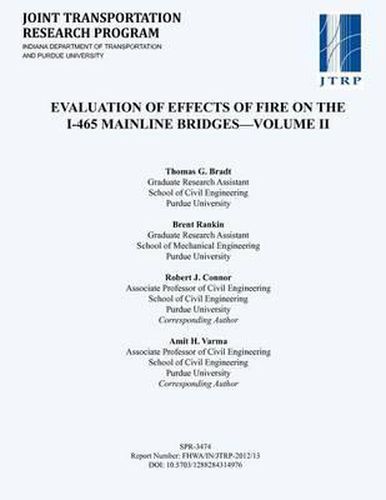Readings Newsletter
Become a Readings Member to make your shopping experience even easier.
Sign in or sign up for free!
You’re not far away from qualifying for FREE standard shipping within Australia
You’ve qualified for FREE standard shipping within Australia
The cart is loading…






Currently, when a bridge has been involved in a fire loading, DOT and inspectors are called to determine if the bridge is passable to traffic. Inspectors must close the bridge for an indefinite period of time to take material samples from the bridge and have them tested to find if the strength of the materials meets AASHTO specifications. This procedure can take time and severely impact the economy of surrounding municipalities due to bridge closure. When a bridge is visually distorted, the recommendations of what must be done to repair the bridge may be intuitive; but when no apparent deformations are visible, a way of inspecting the bridge should be uniform and easily performed. The implementation of the findings of this report and the included inspection guide will provide inspectors a general idea of the changes in material properties of the bridge steel, based on the visual appearance of the steel. A method of testing has been developed that allows researchers to take flange and web sections from a bridge girder and test them in real fire scenarios. The test setup allows researchers to examine the differences in outcomes due to a variety of paint coatings on the steel, thickness of steel, temperature and duration of fire exposure. After each different test, material properties may be determined and compared to virgin or unexposed steel and AASHTO specifications to see if the material properties have changed or if the material is below minimum standards. Each specific test is photographed at certain stages that would be seen at a bridge in the field after being involved in a fire. These photographs can then be compared to actual bridge damage and an estimate of surface temperature could be attained. The inspection guide would then give average values for the reduction or increase of tensile strength and toughness for a particular bridge.
$9.00 standard shipping within Australia
FREE standard shipping within Australia for orders over $100.00
Express & International shipping calculated at checkout
Currently, when a bridge has been involved in a fire loading, DOT and inspectors are called to determine if the bridge is passable to traffic. Inspectors must close the bridge for an indefinite period of time to take material samples from the bridge and have them tested to find if the strength of the materials meets AASHTO specifications. This procedure can take time and severely impact the economy of surrounding municipalities due to bridge closure. When a bridge is visually distorted, the recommendations of what must be done to repair the bridge may be intuitive; but when no apparent deformations are visible, a way of inspecting the bridge should be uniform and easily performed. The implementation of the findings of this report and the included inspection guide will provide inspectors a general idea of the changes in material properties of the bridge steel, based on the visual appearance of the steel. A method of testing has been developed that allows researchers to take flange and web sections from a bridge girder and test them in real fire scenarios. The test setup allows researchers to examine the differences in outcomes due to a variety of paint coatings on the steel, thickness of steel, temperature and duration of fire exposure. After each different test, material properties may be determined and compared to virgin or unexposed steel and AASHTO specifications to see if the material properties have changed or if the material is below minimum standards. Each specific test is photographed at certain stages that would be seen at a bridge in the field after being involved in a fire. These photographs can then be compared to actual bridge damage and an estimate of surface temperature could be attained. The inspection guide would then give average values for the reduction or increase of tensile strength and toughness for a particular bridge.